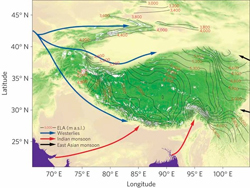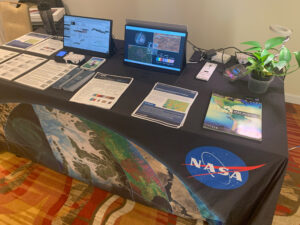
Glacier location and size on the Tibetan Plateau is a function of the region’s massive topographic landforms combined with precipitation patterns of the summer Indian monsoon (on plateau’s Southern/SE flanks), winter westerlies (along plateau’s SW and NW flanks), and the East Asian monsoon patterns to the East. Yao and colleagues saw the most dramatic glacier shrinkage in the southeastern part of the Tibetan Plateau where glacier length decreased on average 48 square meters per year. Glaciers shrank the least in the northwestern reaches of the Tibetan Plateau, in the Pamir region. The authors contribute the varying glacier statuses to changing precipitation levels from the weakening Indian Monsoon (decreasing precipitation) and strengthening westerlies (increasing precipitation).
Changing glacier size could impact water supply of the many rivers fed by the glaciers. These rivers are important sources of water and power in the region and can impact the livelihoods of over a billion people.
Reference:
+ Tandong Yao, Lonnie Thompson, Wei Yang, Wusheng Yu, Yang Gao, Xuejun Guo, Xiaoxin Yang, Keqin Duan, Huabiao Zhao, Baiqing Xu, Jiancheng Pu, Anxin Lu, Yang Xiang, Dambaru B. Kattel & Daniel Joswiak (2012). Different glacier status with atmospheric circulations in Tibetan Plateau and surroundings. Nature Climate Change, 15 July 2012, doi:10.1038/nclimate1580.

Landsat & LCLUC: Science Meeting Highlights
Outreach specialists from the Landsat Communications and Public Engagement team participated in community engagement efforts at the joint NASA and University of Maryland Land Cover Land Use Change (LCLUC) meeting.





